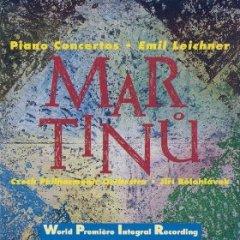Bohuslav Martinu - Piano Concertos 1-5 (1993)
Bohuslav Martinu - Piano Concertos 1-5 (1993)

CD 1 Concerto for Piano and Orchestra No. 1 in D major, H. 149 00:29:15 1. Allegro moderato 00:10:38 2. Andante 00:07:42 3. Allegro 00:10:47 Concerto for Piano and Orchestra No. 2, H. 237 00:24:34 1. Allegro moderato 00:09:11 2. Poco andante 00:07:53 3. Poco allegro 00:07:26 Concertino for Piano and Orchestra, H. 269 00:21:55 1. Allegro moderato (Comodo) 00:06:27 2. Lento 00:09:13 3. Allegro 00:06:12 CD 2 Concerto for Piano and Orchestra No. 3, H. 316 00:29:30 1. Allegro 00:09:01 2. Andante poco moderato 00:10:54 3. Moderato. Allegro 00:09:34 Concerto for Piano and Orchestra No. 4 /Incantations/, H. 358 00:19:40 1. Poco allegro 00:09:45 2. Poco moderato 00:09:52 Concerto for Piano and Orchestra No. 5 in B flat major /Fantasia concertante/, H. 366 00:24:52 1. Poco allegro risoluto 00:07:43 2. Poco andante 00:10:19 3. Poco allegro 00:06:44 Emil Leichner – piano Czech Philharmonic Orchestra Jiri Belohlavek - conductor
This 2-CD set -- with Jiri Belohlavek with the Czech Philharmonic Orchestra, Emil Leichner at the piano -- has first-rate interpretations of Martinu's 5 Piano Concertos and the 1938 Concertino. The closing Allegro of Martinu's 1938 Concertino is a fair representation of this entire set. Although only one of its nine movements, it will serve in this account as a microcosm or sample to consider various aspects of this music in contrast with the mentioned Naxos release.
The Czechs summon crescendos effectively in this movement, and can also develop contemplative passages of great subtlety. The rhythmic core of the music is also far better in hand than in the Naxos version, with much sharper execution. The sound spacing to suit the music's needs is also better considered in the Supraphon set: adjusting better in terms both of shifting instrumental groups into the back or foreground for emphasis, as well as in dynamics according to dramatic needs.
This results in a performance that is full of conviction: strident and razor-sharp as needed, yet well-nuanced where sensitivity is required. Belohlavek coaxes colour and ornamentation from the orchestra both to accent and add contour to the soloist's part, rather than acting in alternation with the pianist (Leichner) - who does not stand out as much in the fore as Koukl, on Naxos. So Belohlavek keeps the pianist more closely integrated with the orchestra (the same holds for the timpanist, incidentally, who also stands out much less than on the Naxos).
The Czech Phil's tighter ensemble delivers slow passages of great refinement while managing robust, hair-raising fortissimo execution when that's called for. This last is done with especially jazzy flair on the trumpets' climactic entry (at 5:10), where you can all but see the players rise and blast out their brief part with dizzy exuberance. Closer attention to the shape of what remains after this peak also brings out some more tightly-wound, eventful music -- just listen to those lovely, long lines of cellos and double basses plucking away, shaping the closing passages, leaving no sense of disappointment when the end arrives. --- Bert vanC Bailey, amazon.com
download: uploaded yandex 4shared mediafire solidfiles mega filecloudio nornar
Last Updated (Wednesday, 12 February 2014 14:11)








